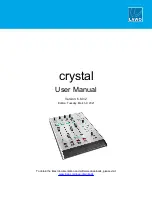
Spectrum Measurements
R&S
®
ESRP
408
User Manual 1175.7445.02 ─ 08
Impact of the RF attenuation setting
The sensitivity of a signal analyzer is directly influenced by the selected RF attenua-
tion. The highest sensitivity is obtained at a RF attenuation of 0 dB. The attenuation
can be set in 10 dB steps up to 70 dB. Each additional 10 dB step reduces the sensitiv-
ity by 10 dB, i.e. the displayed noise is increased by 10 dB.
Impact of the resolution bandwidth
The sensitivity of a signal analyzer also directly depends on the selected bandwidth.
The highest sensitivity is obtained at the smallest bandwidth (1 Hz). If the bandwidth is
increased, the reduction in sensitivity is proportional to the change in bandwidth. The
R&S
ESRP has bandwidth settings in 1, 2, 3, 5 sequence. Increasing the bandwidth by
a factor of 3 increases the displayed noise by approx. 5 dB (4.77 dB precisely). If the
bandwidth is increased by a factor of 10, the displayed noise increases by a factor of
10, i.e. 10 dB.
Impact of the video bandwidth
The displayed noise of a signal analyzer is also influenced by the selected video band-
width. If the video bandwidth is considerably smaller than the resolution bandwidth,
noise spikes are suppressed, i.e. the trace becomes much smoother. The level of a
sine wave signal is not influenced by the video bandwidth. A sine wave signal can
therefore be freed from noise by using a video bandwidth that is small compared with
the resolution bandwidth, and thus be measured more accurately.
Impact of the detector
Noise is evaluated differently by the different detectors. The noise display is therefore
influenced by the choice of detector. Sine wave signals are weighted in the same way
by all detectors, i.e. the level display for a sine wave RF signal does not depend on the
selected detector, provided that the signal-to-noise ratio is high enough. The measure-
ment accuracy for signals in the vicinity of intrinsic signal analyzer noise is also influ-
enced by the detector which has been selected. For details on the detectors of the
R&S
ESRP refer to chapter "Instrument Functions", section "Detector overview" or the
Online Help.
6.4.4.1
Measurement Example – Measuring Level at Low S/N Ratios
The example shows the different factors influencing the S/N ratio.
Signal generator settings (e.g. R&S SMW):
Frequency:
128 MHz
Level:
- 90 dBm
Procedure:
1. Set the R&S
ESRP to its default state by pressing the PRESET key.
The R&S
ESRP is in its default state.
Advanced Measurement Examples
















































